Risk Assessment of Riverine Terraces: The Case of the Chenyulan River Watershed in Nantou County, Taiwan
Abstract
:1. Introduction
Study Area
2. Literature Review
2.1. The Front of the Terrace
2.1.1. The Attack Shore
2.1.2. Distance from Fault
2.1.3. Distance from River
2.1.4. Potential Stream-Impact Quantity
2.2. The River Terrace Itself
2.2.1. Minimum Ratio
2.2.2. Average Slope
2.2.3. Geology
2.3. Rear of the Terrace
2.3.1. Number of Erosion Ditches
2.3.2. Number of Collapses from the Rear
2.4. Preservation-Factor Assessment
3. Methods
3.1. Questionnaire Design
3.2. Questionnaire Survey Subjects
3.3. Statistical Results of Questionnaire Recovery
4. Results
4.1. Distribution Method
4.2. Factor-by-Factor Allocation
5. Discussion
5.1. Risk Assessment of River Terraces
5.2. Verification
5.3. Historical Disaster Comparison
5.3.1. Dangerous River Terraces
5.3.2. County Pit I
5.3.3. Toutunxi Terrace I
6. Conclusions
Author Contributions
Funding
Institutional Review Board Statement
Informed Consent Statement
Data Availability Statement
Acknowledgments
Conflicts of Interest
References
- Li, X.D. From the point of view of topography, Chen Youlan’s He Bo Feng disaster. Geotech. Technol. 1996, 17–24. Available online: http://www.geotech.org.tw/purchase-inner.php?id=131 (accessed on 15 November 2021).
- Liu, M.X. Topographical Research on the River Steps in the Northwest of Taiwan. Ph.D. Thesis, Department of Geography, National Taiwan Normal University, Taipei, Taiwan, 2004. [Google Scholar]
- Du, H.Y.; Chen, H.H.; Cao, B.X. Geomorphology and Quaternary Geology; one edition of Three Brushes; Geological Publishing House: Beijing, China, 1991. [Google Scholar]
- Chang, R.J.; Shi, Z.T. An overview of the study of the rivers. J. Chin. Geogr. Soc. 1990, 18, 1–8. [Google Scholar]
- Ger, M.L. A Study of the Relations between the Terraces and Subsurface Structure in the Hsinshe Area. Ph.D. Thesis, Department of Geography, National Taiwan Normal University, Taipei, Taiwan, 2005. [Google Scholar]
- Wang, F.T. Comparison of River Terraces in Hua-Tung Coast Area: A Case Study in Streams of Shuilian, Shuimuding and Sanxian. Master’s Thesis, Department of History and Geography, University of Taipei, Taipei, Taiwan, 2016. [Google Scholar]
- Chang, T.Y. Fluvial Terrace Landscape in Tai-Yuan Basin and Its Implications. Master’s Thesis, Department of Natural Resources and Environmental Studies, National Dong Hwa University, Hualien County, Taiwan, 2016. [Google Scholar]
- Wu, T.Y. Holocene Landscape Evolution of the Jinlun, Dazhu and Dawu River Basins in the Southeastern Taiwan. Master’s Thesis, Department of Geography, National Kaohsiung Normal University, Kaohsiung, Taiwan, 2019. [Google Scholar]
- Chen, Y.C. Application of Geographic Information System in Risk Asssessment of River Terrace in Chenyulan River Watershed, Nantou County. Master’s Thesis, Department of Civil and Construction Engineering, Chaoyang University of Technology, Taichung, Taiwan, 2010. [Google Scholar]
- Zhuang, Z.Z. Apply Artificial Intelligence and Weight of Evidence to Assess Vulnerability for River Terrace Communities. Master’s Thesis, Department of Land Management and Development, Chang Jung Christian University, Tainan, Taiwan, 2020. [Google Scholar]
- Lin, J.R. Risk Assessment of Rainfall-induced Landslides for River Terrace Communities. Master’s Thesis, Department of Land Management and Development, Chang Jung Christian University, Tainan, Taiwan, 2020. [Google Scholar]
- Chang, C.F. Effects of Watershed Runoff Factors on Debris Flow Occurrence–Using the Watershed of Chenyoulan Stream as An Example. Master’s Thesis, Department of Bioenvironmental Systems Engineering, National Taiwan University, Taipei, Taiwan, 2015. [Google Scholar]
- Lin, S.Y. Study on the Factors of Landslide Susceptibility Analysis in Chen- You-Lan Watershed. Master’s Thesis, Department of Soil and Water Conservation, National Chung Hsing University, Taichung, Taiwan, 2018. [Google Scholar]
- Thi-To, N.N. Early Warning of Landslide Hazard by Integrating Spatial Statistical Analysis Methods to Calculate the Landslide Susceptibility Index in the Chen-Yu-Lan River Watershed. Taiwan. Ph.D. Thesis, Department of Earth Sciences, National Cheng Kung University, Tainan, Taiwan, 2019. [Google Scholar]
- Debris Flow Disaster Prevention Information, Soil and Water Conservation Bureau. Available online: https://246.swcb.gov.tw/?lang=en (accessed on 15 November 2021).
- Lin, M.L.; Wu, W.L.; Zhou, K.X.; Yang, Z.S.; Wang, J.P. Discussion on Geographical Location Types and Remediation Cases of Taiwan Slope Disasters. CECI Eng. Technol. 2008, 77. Available online: https://www.ceci.org.tw/Upload/Download/F8950026-85C8-4386-9075-13CCB737881D.pdf (accessed on 15 November 2021).
- Lin, D.G.; Lai, Y.C.; Liu, W.T. Design and analysis of natural ecological method for river and stream improvement. In Proceedings of the Natural Ecological Practices Conference, Taitpi, Taiwan, November 2002; Available online: https://www.m.ishare.iask.sina.com.cn/f/34860363.html (accessed on 15 November 2021).
- Su, K.H. Investigating the Slope Failure of Interbedded Sandstone and Mudstone Slope: Case of Highway R174 on 50 k + 650. Master’s Thesis, Institute of Resources and Environment, University of Kang Ning, Taipei, Taiwan, 2007. [Google Scholar]
- Central Weather Bureau. Available online: https://www.cwb.gov.tw/eng/ (accessed on 15 November 2021).
- Lin, C.W. Geological Factors to Influence the Landslides in The Hoshe Area, Nantou Hsien. Sino-Geotech. 1996, 57, 5–16. [Google Scholar]
- Wang, M.H. Application of SPOT Satellite Images and GIS for Landslide Potential Analysis-A Case Study of Shao-Lai River. Master’s Thesis, Department of Civil and Construction Engineering, Chaoyang University of Technology, Taichung, Taiwan, 2008. [Google Scholar]
- Chu, Y.T.; Hsu, M.L. The Relationship between Discharge and Suspended Sediment Concentration at Typhoon Events in Yu-Feng Catchment. J. Geogr. Sci. 2007, 49, 1–22. [Google Scholar]
- Huang, T.H. The Study of Slope Landslide Disaster Management-Take Tainan County for Example. Master’s Thesis, Department of Land Management and Development, Chang Jung Christian University, Tainan, Taiwan, 2004. [Google Scholar]
- Zhang, L.; Weng, Y.; Chen, X.H. Research on evaluation model for vulnerability of flood control based on SVM. Yangtze River 2009, 40. [Google Scholar]
- Lin, C.K. Topography of Taiwan, Taiwan Provincial General Records 1957, 1. (Land Records, Geography, Volume 1), published by the Taiwan Provincial Literature Committee, 424 pp. Available online: https://tm.ncl.edu.tw/article?u=006_001_0000395034&lang=chn (accessed on 15 November 2021).
- Lin, C.C. Topography of Taiwan, Draft of the General Gazetteer of Taiwan Province, Taiwan Provincial Literature Committee. 1, 1957.
- Wang, L.C. The Characteristics of Topography and Occurrence of Hillslope Debris Flows in Shitou area. Master’s Thesis, Department of Earth Sciences, National Cheng Kung University, Tainan, Taiwan, 2005. [Google Scholar]
- Cheng, Y.C. Application of Geographic Information System to Regional Slope Stability Analysis—Tianxiang-Tailuege Section of Zhongheng Highway. Master’s Thesis, Department of Materials Science and Engineering, National Cheng Kung University, Tainan, Taiwan, 1992. [Google Scholar]
- Kao, C.L. A Study on the Failure Potential of Slopes along 31~75 K Section of the 14th Provential Highway. Master’s Thesis, Department of Civil and Construction Engineering, Chaoyang University of Technology, Taichung, Taiwan, 2003. [Google Scholar]
- Liu, H.F. Evaluation of Slope Failures along the 14th Provincial Highway Using Artificial Neural Networks. Master’s Thesis, Department of Civil and Construction Engineering, Chaoyang University of Technology, Taichung City, Taiwan, 2005. [Google Scholar]
- Hou, C.F. Application of SPOT Remote Sensing Images and GIS on Landslide potential Analysis Using Chen Yu Lan Creek Basin. Master’s Thesis, Department of Civil and Construction Engineering, Chaoyang University of Technology, Taichung, Taiwan, 2006. [Google Scholar]
- Luo, S.Y.; Huang, H.Y. Chenyulan. Available online: http://www1.geo.ntnu.edu.tw/~shensm/Course/CourseWork/TaiGeom_Stu90/24.25%E9%99%B3%E6%9C%89%E8%98%AD%E6%BA%AA/ (accessed on 15 November 2021).
- Jeng, F.S.; Lin, M.L. Engineering Deficiencies Exposed by Typhoon Herb. Sino-Geotech. 1996, 57, 65–74. [Google Scholar]
- Chang, W.C. Research on the Sustainability of Debris Flow Influenced Areas in Yilan County with the Application of the Fuzzy Backpropagation Neural Network Deduction Pattern. Master’s Thesis, Department of Civil Engineering, National Ilan University, Ilan, Taiwan, 2006. [Google Scholar]
- Taiwan’s Water Resources Agency, MOEA. Available online: https://eng.wra.gov.tw/ (accessed on 15 November 2021).
- Chang, S.J. Hillside Survey Planning, Evaluation and Slump Prediction and Management. Master’s Thesis, Department of Geography, National Taiwan Normal University, Taibei, Taiwan, 1993. [Google Scholar]
- Hung, J.J. Typhoon Herb, The New-Central-Cross-Island-Highway and Slopeland Failures in Central Taiwan. Sino-Geotechnics 1996, 57, 25–30. [Google Scholar]
- Tarng, H.R. The Transportation and Deposition of Catastrophic Landslides in Taiwan: Insight from Granular Discrete Element Simulation. Ph.D. Thesis, Department of Geosciences, National Taiwan University, Taibei, Taiwan, 2010. [Google Scholar]
- Chi, C.C. Investigation and Interpretation of Rock Slide Potential. Nation Sci. Technol. Cent. Disaster Reduct. 2010, 62. Available online: https://www.ncdr.nat.gov.tw/Epaper/MessageView?itemid=5061&mid=39 (accessed on 15 November 2021).
- Saaty, T.L.; Vargas, T.L. Comparision of igenvalue, logarithmic least squares and least squares medthods in estimationg ratios Mathematic. Modelling 1984, 5, 309–324. [Google Scholar] [CrossRef] [Green Version]
- Shrestha, R.K.; Alavalapati, J.R.; Kalmbacher, R.S. Exploring the potential for silvopasture adoption in south-central Florida: An application of SWOT–AHP method. Agric. Syst. 2004, 81, 185–199. [Google Scholar] [CrossRef]
- Juang, C.H.; Chen, C.J. A rational method for development of limit state for liquefaction evaluation based on shear wave velocity measurements. Int. J. Numer. Anal. Methods Geomech. 2000, 24, 1–27. [Google Scholar] [CrossRef]
- Lai, M.F. Application of GIS to Spatial Characteristic of Rainfall—Chenyulan River Watershed as an Example. Master’s Thesis, Department of Civil and Construction Engineering, Chaoyang University of Technology, Taichung, Taiwan, 2010. [Google Scholar]
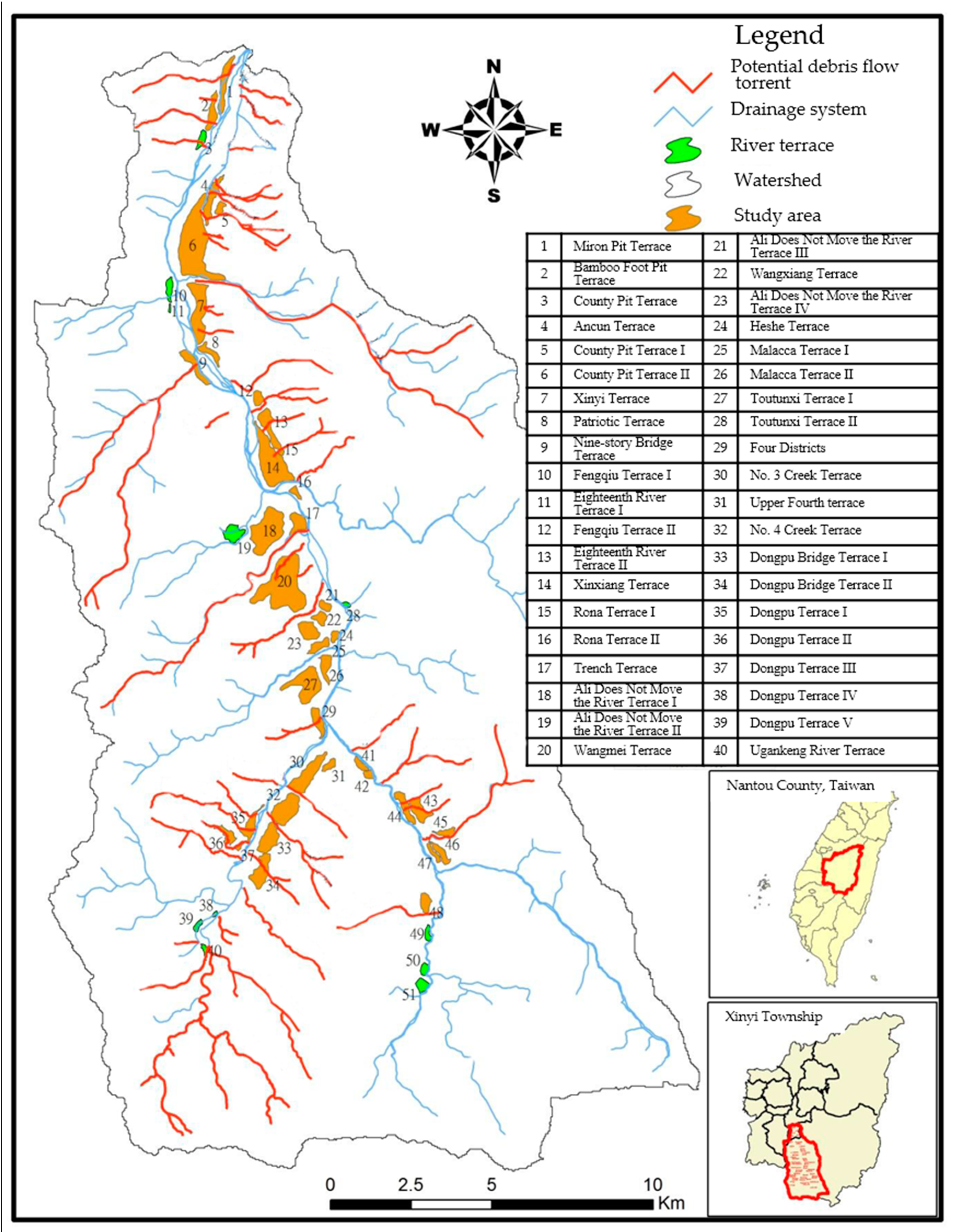
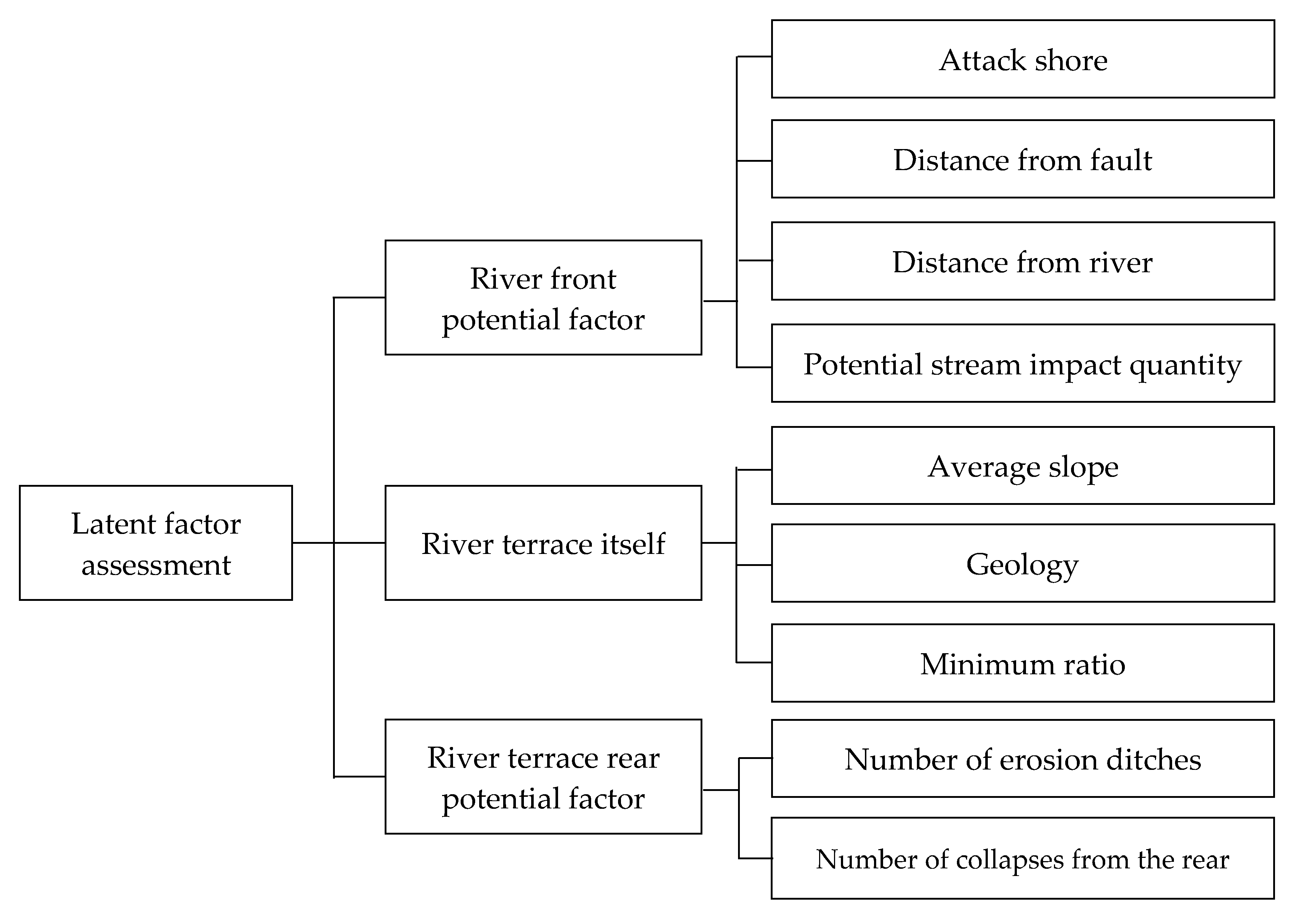

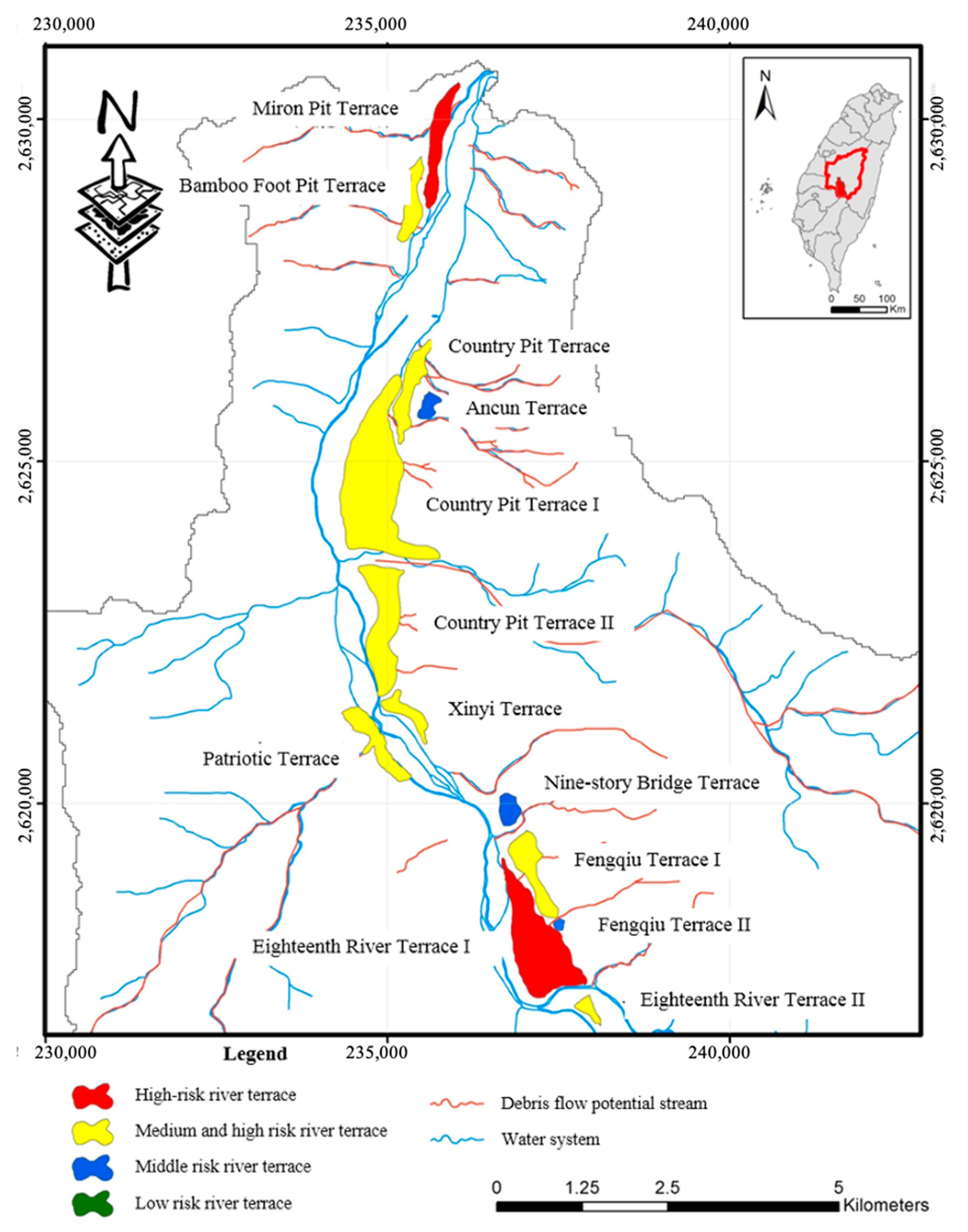
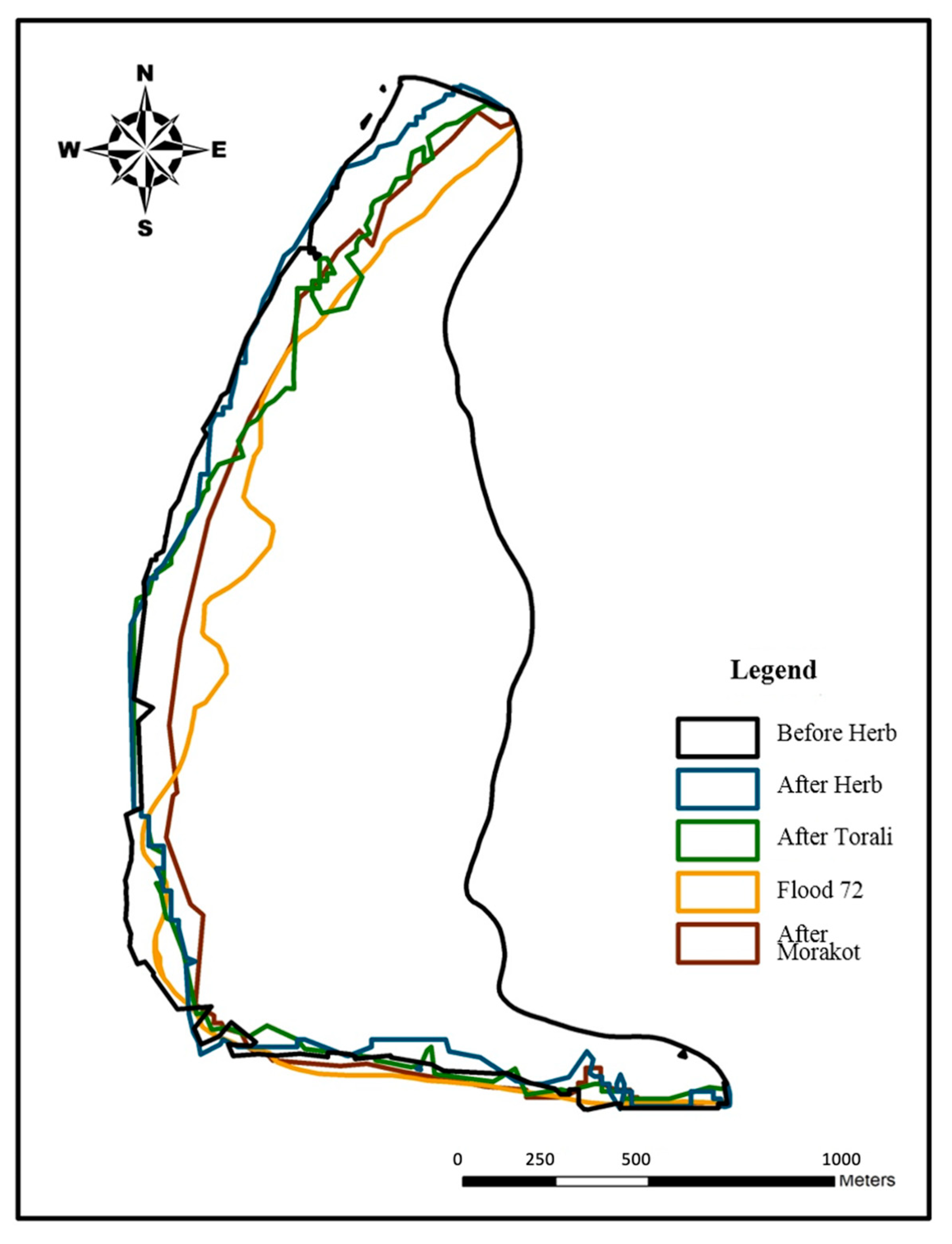
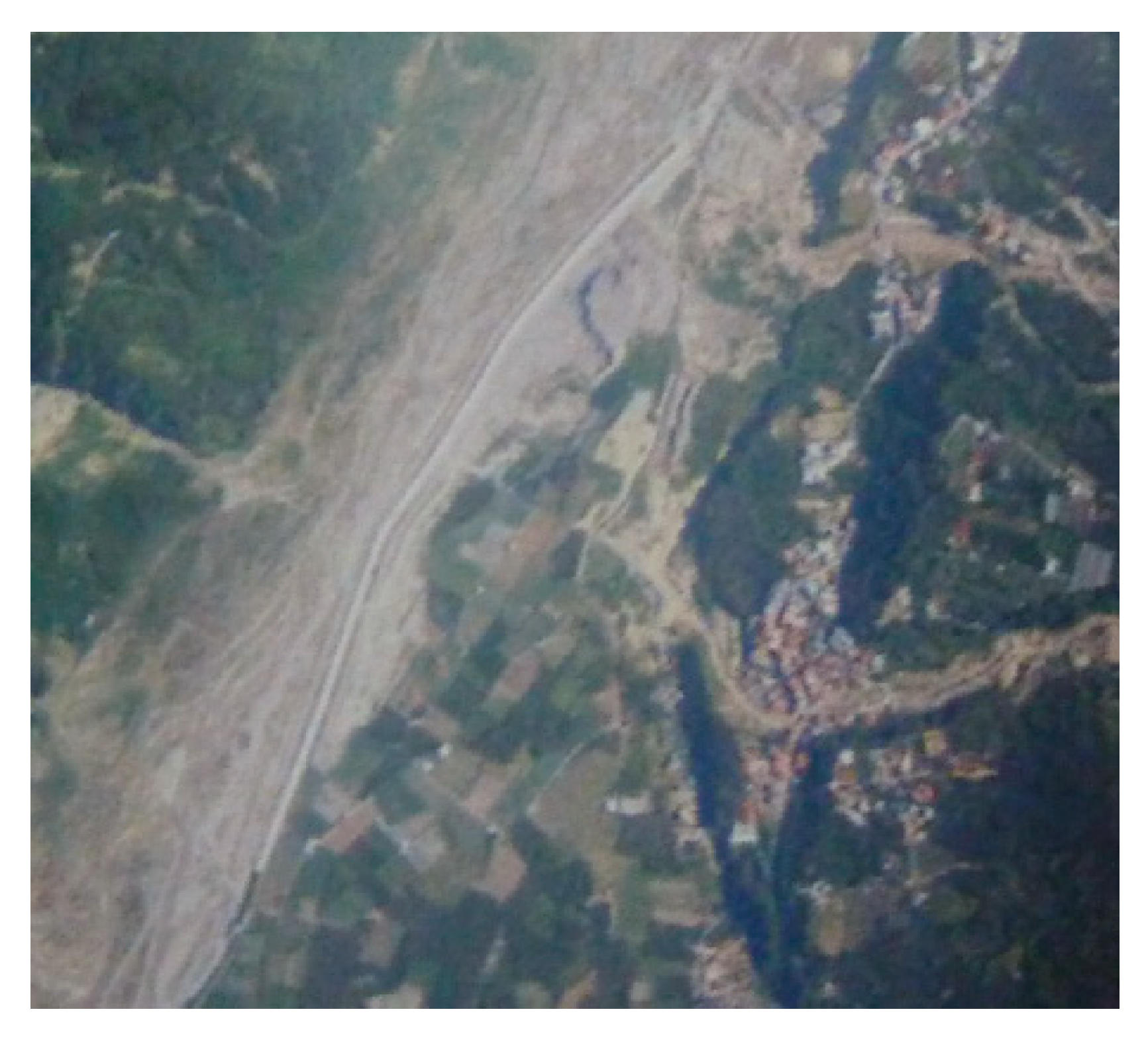
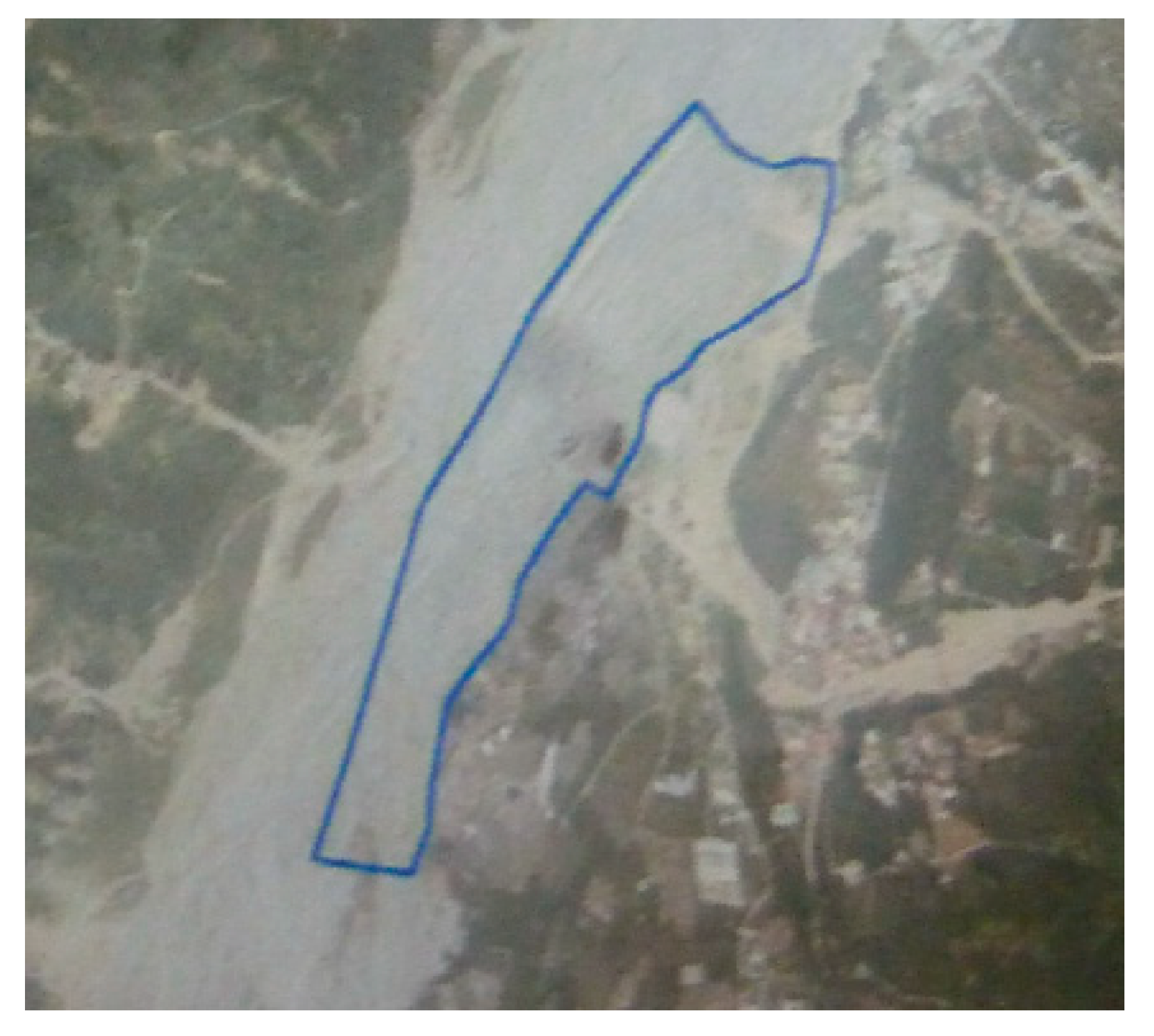


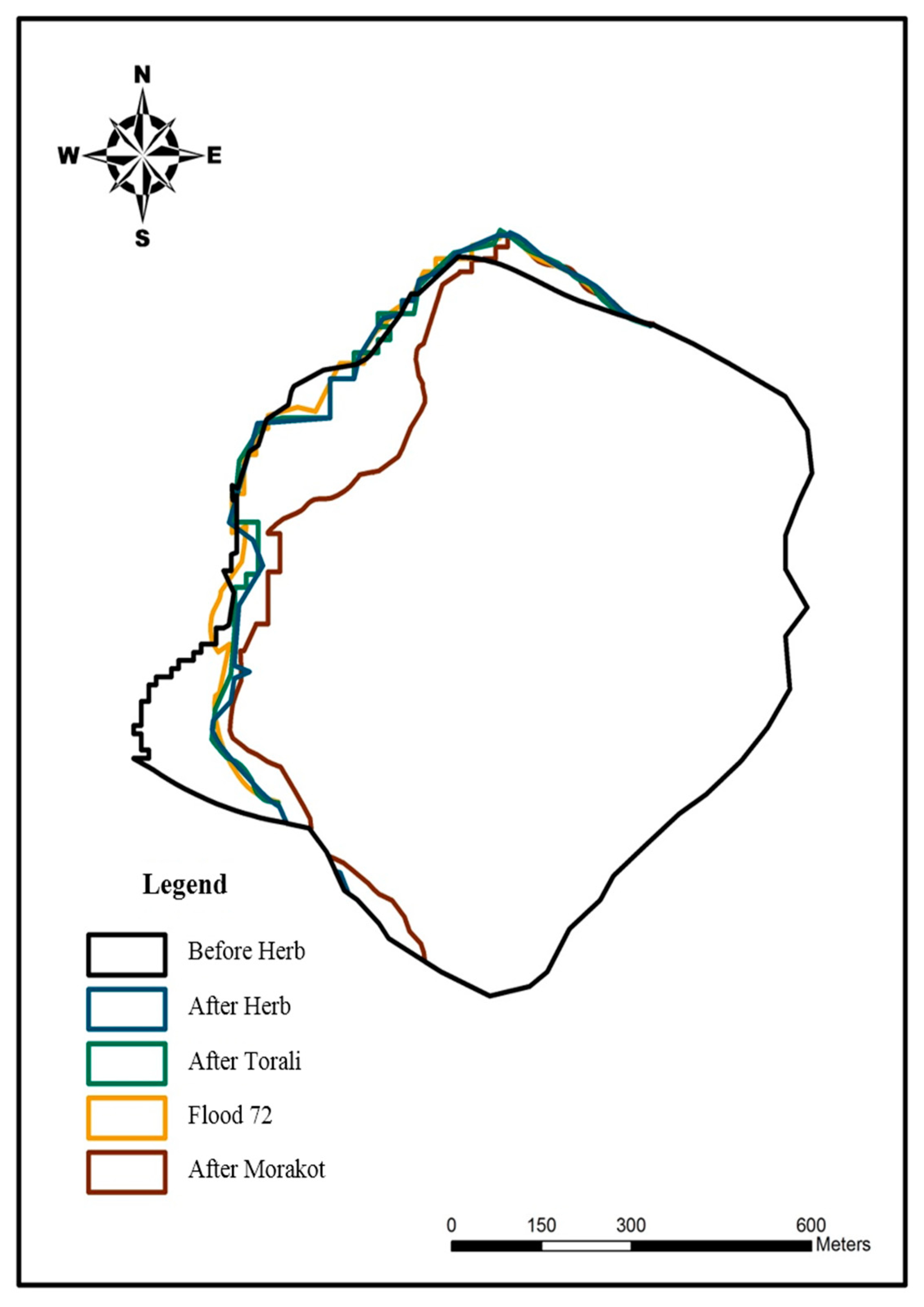
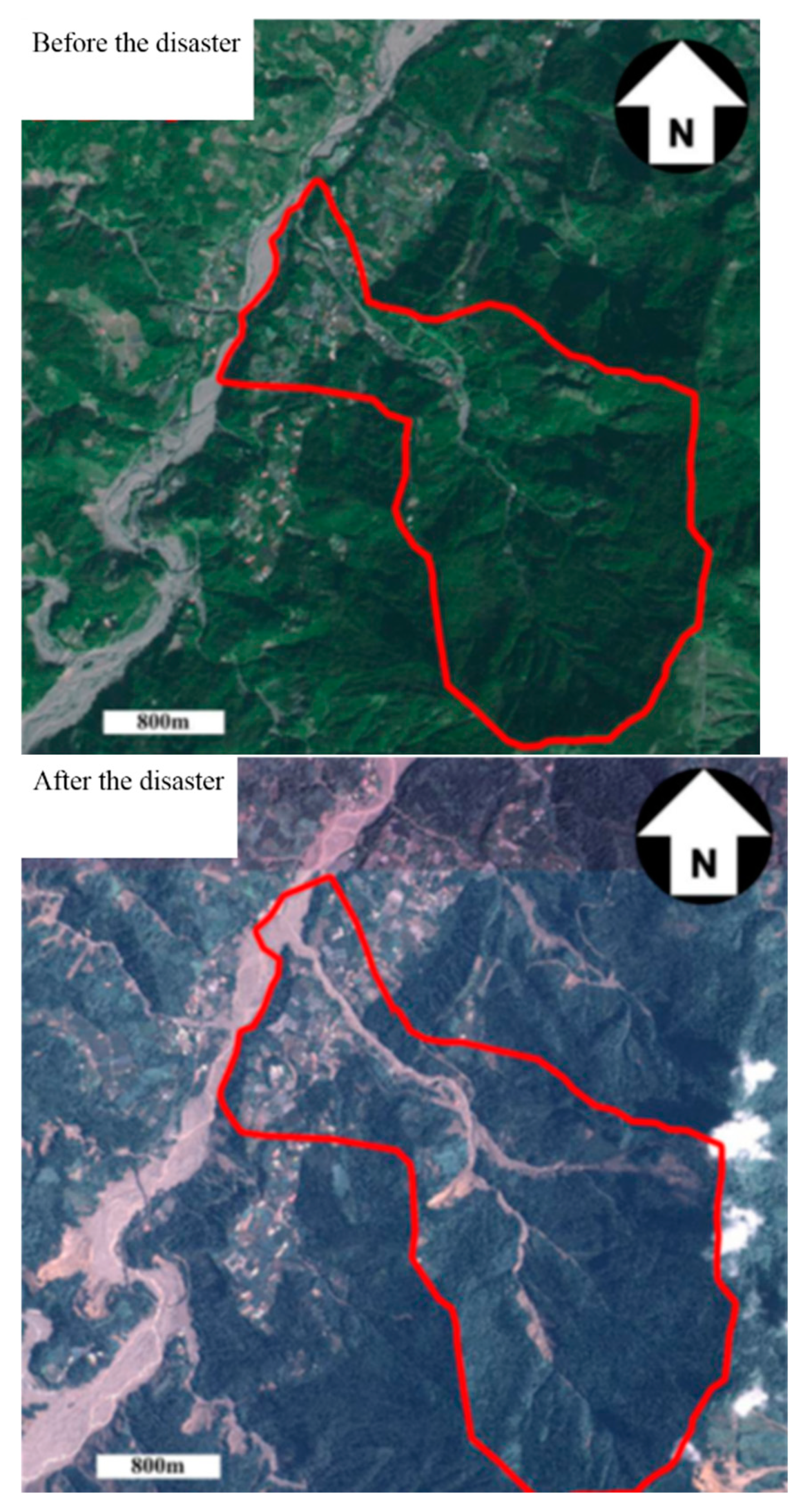
| Level | Evaluation Project | Inter-Level Weight | Overall Weight | Rank | |
|---|---|---|---|---|---|
| Level one | Latent factor assessment | 1.000 | 1.000 | ||
| Level two | Latent factor assessment | In front of river terrace | 0.352 | 0.352 | |
| River terrace itself | 0.342 | 0.342 | |||
| Behind river terrace | 0.306 | 0.306 | |||
| Level three | In front of river terrace | Attack shore | 0.379 | 0.133 | 3 |
| Distance from fault | 0.096 | 0.034 | 9 | ||
| Distance from river | 0.288 | 0.101 | 7 | ||
| Potential impact of debris-flow quantity | 0.237 | 0.083 | 8 | ||
| Level three | River terrace itself | Average slope | 0.321 | 0.110 | 6 |
| Geology | 0.354 | 0.121 | 4 | ||
| Minimum ratio | 0.325 | 0.111 | 5 | ||
| Level three | Behind river terrace | Number of erosion ditches | 0.563 | 0.172 | 1 |
| Distance from the collapse | 0.438 | 0.134 | 2 | ||
| Level | Evaluation Project | Inter-Level Weight | Overall Weight | |
|---|---|---|---|---|
| Level one | Preservation factor assessment | 1.000 | 1.000 | |
| Level two | Preservation factor assessment | Protected address | 0.599 | 0.599 |
| Traffic | 0.292 | 0.292 | ||
| Farmland | 0.109 | 0.109 | ||
| Factors | Average Value | Standard Deviation | Xmax–Xmin |
|---|---|---|---|
| Minimum height ratio (m) | 58.6 | 64.4 | 0–123 |
| Attack shore length (m) | 213.9 | 375.1 | 0–589 |
| Distance from river (m) | 182.2 | 202.3 | 0–384.4 |
| Average slope (degrees) | 10.4 | 4.5 | 5.9–14.8 |
| Distance from fault (m) | 388.6 | 455.2 | 0–843.7 |
| Number of potential streams affected | 2.2 | 2.1 | 1.1–5.3 |
| Number of erosion ditches | 3.2 | 2.5 | 0.7–5.6 |
| Distance from the collapse (m) | 654.2 | 388.7 | 285.5–1022.9 |
| Protected address | 91.1 | 130.1 | 0–221.1 |
| Factors | Maximum Weighting | Minimum Weighting | |
|---|---|---|---|
| Latent susceptibility factors | Minimum height ratio (m) | 11.1 | 1.11 |
| Attack shore length (m) | 13.3 | 1.33 | |
| Distance from river (m) | 10.1 | 1.01 | |
| Average slope (degrees) | 11.0 | 1.1 | |
| Distance from fault (m) | 3.4 | 0.34 | |
| Number of potential streams affected | 8.3 | 0.83 | |
| Geology | 12.1 | 1.21 | |
| Number of erosion ditches | 17.2 | 1.72 | |
| Distance from the collapse (m) | 13.4 | 1.34 | |
| Total | 100 | 10 | |
| Preservation factors | Protected address | 59.9 | 5.99 |
| Traffic | 29.3 | 2.93 | |
| Farmland | 10.9 | 1.09 | |
| Total | 100 | 10 | |
| No. | River Terrace Name | Risk | Hazard Classification |
|---|---|---|---|
| 1 | Miron Pit Terrace | 67 | Medium high |
| 2 | Bamboo Foot Pit Terrace | 59 | Medium high |
| 3 | County Pit Terrace | 72 | High |
| 4 | Ancun Terrace | 49 | Medium |
| 5 | County Pit Terrace I | 79 | High |
| 6 | County Pit Terrace II | 85 | High |
| 7 | Xinyi Terrace | 81 | High |
| 8 | Patriotic Terrace | 78 | High |
| 9 | Nine-story Bridge Terrace | 49 | Medium |
| 10 | Fengqiu Terrace I | 66 | Medium high |
| 11 | Eighteenth River Terrace I | 76 | High |
| 12 | Fengqiu Terrace II | 45 | Medium high |
| 13 | Eighteenth River Terrace II | 53 | Medium high |
| 14 | Xinxiang Terrace | 53 | Medium high |
| 15 | Rona Terrace I | 55 | Medium |
| 16 | Rona Terrace II | 70 | High |
| 17 | Trench Terrace | 38 | Low |
| 18 | Ali Does Not Move the River Terrace I | 35 | Low |
| 19 | Ali Does Not Move the River Terrace II | 65 | Medium high |
| 20 | Wangmei Terrace | 50 | Medium |
| 21 | Ali Does Not Move the River Terrace III | 39 | Low |
| 22 | Wangxiang Terrace | 49 | Medium |
| 23 | Ali Does Not Move the River Terrace IV | 68 | Medium high |
| 24 | Heshe Terrace | 78 | High |
| 25 | Malacca Terrace I | 59 | Medium high |
| 26 | Malacca Terrace II | 42 | Medium |
| 27 | Toutunxi Terrace I | 67 | Medium high |
| 28 | Toutunxi Terrace II | 59 | Medium high |
| 29 | Four Districts | 44 | Medium |
| 30 | No. 3 Creek Terrace | 65 | Medium high |
| 31 | Upper Fourth terrace | 37 | Low |
| 32 | No. 4 Creek Terrace | 41 | Medium |
| 33 | Dongpu Bridge Terrace I | 55 | Medium high |
| 34 | Dongpu Bridge Terrace II | 52 | Medium |
| 35 | Dongpu Terrace I | 50 | Medium |
| 36 | Dongpu Terrace II | 62 | Medium high |
| 37 | Dongpu Terrace III | 47 | Medium |
| 38 | Dongpu Terrace IV | 63 | Medium high |
| 39 | Dongpu Terrace V | 57 | Medium high |
| 40 | Ugankeng River Terrace | 49 | Medium |
Publisher’s Note: MDPI stays neutral with regard to jurisdictional claims in published maps and institutional affiliations. |
© 2022 by the authors. Licensee MDPI, Basel, Switzerland. This article is an open access article distributed under the terms and conditions of the Creative Commons Attribution (CC BY) license (https://creativecommons.org/licenses/by/4.0/).
Share and Cite
Lin, J.-Y.; Chao, J.-C.; Hsu, Y.-M. Risk Assessment of Riverine Terraces: The Case of the Chenyulan River Watershed in Nantou County, Taiwan. Appl. Sci. 2022, 12, 1375. https://doi.org/10.3390/app12031375
Lin J-Y, Chao J-C, Hsu Y-M. Risk Assessment of Riverine Terraces: The Case of the Chenyulan River Watershed in Nantou County, Taiwan. Applied Sciences. 2022; 12(3):1375. https://doi.org/10.3390/app12031375
Chicago/Turabian StyleLin, Ji-Yuan, Jen-Chih Chao, and Yung-Ming Hsu. 2022. "Risk Assessment of Riverine Terraces: The Case of the Chenyulan River Watershed in Nantou County, Taiwan" Applied Sciences 12, no. 3: 1375. https://doi.org/10.3390/app12031375
APA StyleLin, J.-Y., Chao, J.-C., & Hsu, Y.-M. (2022). Risk Assessment of Riverine Terraces: The Case of the Chenyulan River Watershed in Nantou County, Taiwan. Applied Sciences, 12(3), 1375. https://doi.org/10.3390/app12031375






